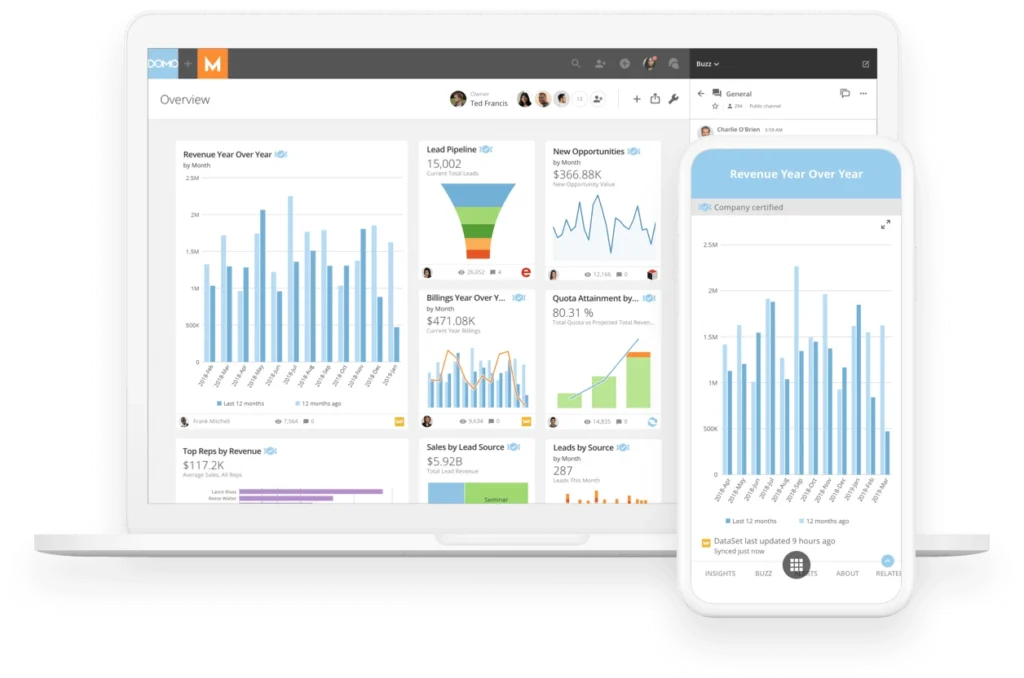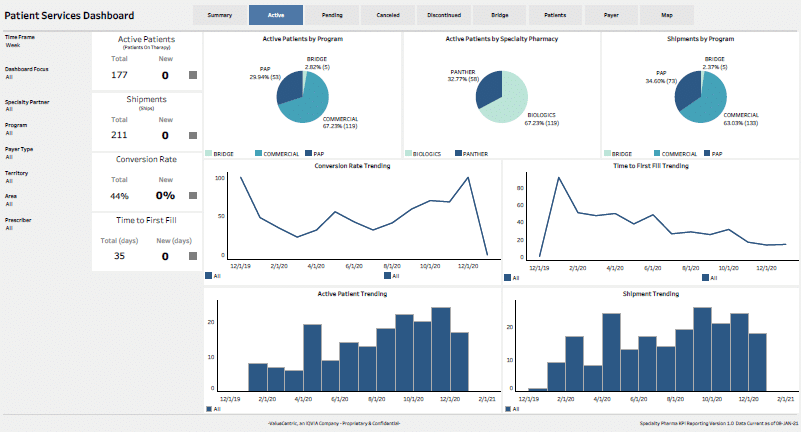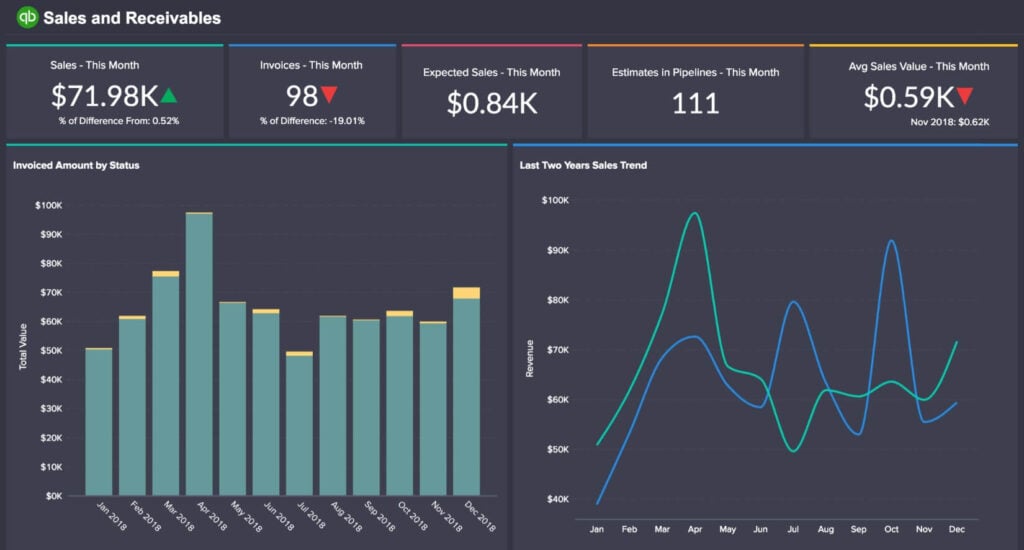12 Best Healthcare BI Tools
After a deep dive into the sea of healthcare BI tools, I've handpicked the top 12 to address your specific needs and overcome challenges. Let's explore!
- Domo - Best for real-time data visualization
- MicroStrategy - Best for enterprise-scale data integration
- IQVIA - Best for real-world health data transformation
- BurstiQ - Best for secure health data exchange
- Qlik - Best for flexible data discovery
- Sisense - Best for embedding analytics in patient workflows
- Tableau - Best for intuitive drag-and-drop data exploration
- Grow - Best for data-driven decision-making in small practices
- Mode - Best for collaborative data science
- Zoho - Best for cloud-based health data management
- Oracle - Best for advanced predictive analytics
- Yellowfin - Best for automated data analysis reporting
Navigating the world of healthcare BI tools can feel like wandering through a labyrinth. But fret not, I'm here to be your guide. I've combed through countless solutions, evaluating each for its unique value and ability to meet the distinct needs of healthcare providers like you. These tools all share a common purpose: they turn your data into powerful, actionable insights.
By utilizing these solutions, you can significantly enhance patient care, streamline administrative tasks, and make well-informed decisions more efficiently. These solutions excel at reducing complexity, automating analytics, and presenting information in an easily digestible way. So, let's explore these powerful resources, tailored to your needs, together. I'm confident that the right tool for you is just a click away.
What Is a Healthcare BI Tool?
Healthcare Business Intelligence (BI) tools are powerful software applications used by medical professionals, administrators, and decision-makers to transform vast amounts of health data into actionable insights. These tools excel in collecting, integrating, analyzing, and presenting data from various sources - such as electronic health records, administrative data, patient feedback, and more - in an easily understandable format.
This process supports informed decision-making, improves patient outcomes, enables predictive analytics, enhances operational efficiency, and fosters cost-effective healthcare delivery. Healthcare BI solutions essentially serve as a lighthouse, guiding healthcare providers through the sea of complex data toward meaningful, patient-centered care.
Overviews of the 12 Best Healthcare BI Tools
1. Domo - Best for real-time data visualization

Domo is a BI tool that specializes in transforming your raw data into insightful visualizations, making the interpretation of complex healthcare data simpler. It's especially adept at real-time data representation, making it an ideal choice for organizations that value immediacy in their analytics.
Why I Picked Domo:
I selected Domo because of its impressive capabilities in delivering real-time data visualization. Not every tool can handle the challenge of presenting data in real-time, and Domo does this in a manner that's both comprehensive and accessible. In healthcare, where time can often equate to life-saving decisions, Domo is unparalleled. That's why it's the "Best for real-time data visualization."
What Do You Get for Free?
Domo does offer a free trial, giving potential users a chance to explore its features before making a commitment. During the trial, you can sample many of its core capabilities, including data integration and visualization. However, real-time data updates and advanced analytic functions may be limited in the free trial.
Standout Features & Integrations:
Domo shines in its real-time data visualization capability, allowing you to understand health data at a glance. It also provides robust data integration that supports a variety of formats and sources. Domo’s integration suite is comprehensive and includes EHR systems like Epic and Cerner, and other popular business applications such as Salesforce, Google Analytics, and Excel.
Pricing:
Pricing for Domo starts from $83/user/month (billed annually). It's important to note that specific pricing depends on your unique needs and is best clarified directly with Domo.
Pros:
- Outstanding real-time data visualization
- Robust integration with a variety of systems
- User-friendly interface and dashboards
Cons:
- Pricing can be on the higher side for small practices
- The real-time update capability might be overwhelming for novice users
- Advanced functions may require some technical knowledge
2. MicroStrategy - Best for enterprise-scale data integration

MicroStrategy is a business intelligence software that excels in consolidating vast amounts of data across an enterprise, enabling healthcare organizations to make data-driven decisions with confidence. Its exceptional performance in data integration makes it an ideal choice for large-scale healthcare systems that handle big data sets from multiple sources.
Why I Picked MicroStrategy:
In choosing MicroStrategy, I considered the intricate and voluminous nature of data that large healthcare enterprises typically handle. MicroStrategy stood out with its robust data integration capabilities, able to weave together data from various sources into a cohesive, comprehensible whole. For this reason, I find it to be the "Best for enterprise-scale data integration."
What Do You Get for Free?
MicroStrategy provides a free version of its software, albeit with limited capabilities. It allows users to familiarize themselves with the basic features of the tool, such as standard reporting and dashboard creation. However, the enterprise-scale data integration feature, among other advanced features, is not available in the free version.
Standout Features & Integrations:
MicroStrategy offers comprehensive data integration, interactive dashboards, and advanced analytics features. It also provides mobile analytics, enabling on-the-go Ad Hoc access for busy healthcare professionals. Key integrations include EHR systems, billing and coding applications, CRM systems like Salesforce, and other popular data sources including Oracle, SAP, and SQL Server.
Pricing:
Pricing for MicroStrategy starts from $600/user/year (billed annually). However, the specific pricing might vary depending upon your organization’s requirements, and it's recommended to get a custom quote from MicroStrategy.
Pros:
- Comprehensive enterprise-scale data integration
- Mobile analytics for on-the-go data access
- Rich features for advanced data analysis
Cons:
- The free version has limited capabilities
- May have a steep learning curve for novice users
- High starting price can be a barrier for smaller practices
3. IQVIA - Best for real-world health data transformation

IQVIA excels in converting real-world health data into meaningful, actionable insights that drive effective decision-making in healthcare organizations. It's unique in its focus on leveraging real-world evidence, making it a powerful tool for healthcare entities dealing with complex, diverse patient data.
Why I Picked IQVIA:
In determining the best BI tool for real-world data transformation, IQVIA was a clear standout. Its strong focus on real-world evidence, combined with powerful analytics capabilities, makes it a compelling choice for those dealing with diverse, real-world health data. Hence, it's my pick as the "Best for real-world health data transformation."
What Do You Get for Free?
IQVIA does not provide a free version or trial of their tool. However, they offer detailed demos and case studies on their website which provide valuable insights into the software's capabilities and use cases.
Standout Features & Integrations:
IQVIA brings together disparate data sets and uses sophisticated algorithms to transform them into meaningful insights. Its standout features include advanced analytics, machine learning or artificial intelligence capabilities, and predictive modeling. IQVIA integrates well with various healthcare databases and electronic health record (EHR) systems, providing a comprehensive view of patient health data.
Pricing:
Pricing for IQVIA is provided upon request, as it offers tailored solutions depending on an organization's specific needs.
Pros:
- Uniquely focused on real-world health data
- Advanced analytics and predictive modeling capabilities
- Robust integration with various healthcare databases and EHR systems
Cons:
- No free version or trial available
- Pricing information is not readily available
- Customized solutions may require a longer implementation process
4. BurstiQ - Best for secure health data exchange

BurstiQ leverages blockchain technology to facilitate secure health data exchange among healthcare organizations. It's committed to ensuring data security and compliance, making it ideal for healthcare entities with stringent data protection needs.
Why I Picked BurstiQ:
When it comes to secure health data exchange, BurstiQ is my first choice. Its use of blockchain technology sets it apart, providing an extra layer of security for sensitive health data. Therefore, I believe it stands as the "Best for secure health data exchange."
What Do You Get for Free?
BurstiQ does not offer a free version or free trial. However, they do provide in-depth consultations and demos to give potential customers a comprehensive understanding of their platform and its capabilities.
Standout Features & Integrations:
BurstiQ offers a robust BI platform with features like data anonymization, smart contracts, and an AI-based analytical engine. It also has excellent integration capabilities with a range of health information systems, ensuring seamless data exchange.
Pricing:
Pricing for BurstiQ is upon request. They tailor the costs according to the specific needs and scale of your organization.
Pros:
- Blockchain technology ensures secure data exchange
- Comprehensive integration capabilities
- Advanced features such as data anonymization and smart contracts
Cons:
- No free version or trial
- Pricing information is not readily available
- May require a learning curve due to advanced features
5. Qlik - Best for flexible data discovery

Qlik Sense stands out as a powerful business intelligence tool that excels in offering flexible and comprehensive self-service data discovery and analytics. It enables users to connect to multiple data sources, making it a fitting choice for diverse data environments.
Why I Picked Qlik:
I picked Qlik because of its dynamic data mining features. Its associative data indexing engine is unique, allowing users to freely navigate and discover data insights in an intuitive manner. These distinctive aspects make it best for flexible data discovery.
What Do You Get for Free?
Qlik offers a free trial that lets users explore all features without limitations. This trial offers a great chance to test Qlik's data discovery capabilities and gauge if it aligns with the needs of your healthcare organization.
Standout Features & Integrations:
Qlik boasts impressive features like associative data indexing, AI-generated insights, and drag-and-drop visualizations. It also integrates with numerous on-premises and cloud data sources and systems, making it highly adaptable in a variety of healthcare data ecosystems.
Pricing:
Qlik's pricing starts from $30/user/month (billed annually). This base plan offers full access to Qlik's core capabilities and is suitable for small to medium-sized organizations.
Pros:
- Exceptional data discovery capabilities
- Integrates with a wide variety of data sources
- User-friendly interface with drag-and-drop visualizations
Cons:
- More expensive than some competitors
- The full value of features may require advanced training
- Large datasets may slow down performance
6. Sisense - Best for embedding analytics in patient workflows

Sisense is a comprehensive business intelligence platform that excels in integrating analytics directly into workflows. Its robust capabilities, including the ability to embed analytics into patient workflows, make it a strong choice for healthcare organizations aiming to streamline their data processes.
Why I Picked Sisense:
I chose Sisense for its innovative approach to data integration and analytics. Its capacity to incorporate analytics into patient workflows sets it apart from many other data tools. These capabilities led me to select Sisense as the top choice for embedding analytics in patient workflows.
What Do You Get for Free?
Sisense provides a free trial that offers a complete experience of its functionalities. The trial allows users to evaluate the tool’s analytics and data integration abilities, including how well it fits within existing patient workflows.
Standout Features & Integrations:
Sisense provides a unique "Elasticube" technology that enables swift handling of large data sets. Its automated monitoring feature helps organization’s to keep track of healthcare KPIs . It also provides impressive integration with various data sources and offers capabilities for creating customizable graphs.
Pricing:
Sisense's pricing begins from $89/user/month (billed annually). This starting price offers a comprehensive package of the platform's key features.
Pros:
- Offers robust embedded analytics
- "Elasticube" technology for efficient data handling
- Extensive integration capabilities
Cons:
- Higher starting price than some competitors
- Some advanced features may require technical expertise
- Can be overwhelming for beginners due to numerous features
7. Tableau - Best for intuitive drag-and-drop data exploration

Tableau is a highly interactive and visual analytics software that enables users to better understand their data. Its powerful drag-and-drop interface allows for easy and intuitive data exploration, making it particularly useful for users who need to navigate large data sets without advanced technical skills.
Why I Picked Tableau:
I selected Tableau due to its exceptional user interface and intuitive drag-and-drop capabilities. This feature makes it distinct from many other data analytics platforms as it allows individuals to easily explore their data. This is why I believe Tableau is the best tool for intuitive drag-and-drop data exploration.
What Do You Get for Free?
Tableau offers a free version of its software called Tableau Public. While this version does provide a substantial range of features, it is limited in that all data published is publicly accessible. For more secure and private data management, users will need to upgrade to a paid version.
Standout Features & Integrations:
Tableau excels in data visualization, with its intuitive and interactive dashboards being a particular highlight. It offers robust integration capabilities, including compatibility with various data sources like SQL databases, cloud services like AWS, and Excel spreadsheets.
Pricing:
The pricing for Tableau starts from $70/user/month (billed annually). This includes access to Tableau Desktop, Tableau Prep Builder, and one creator license of Tableau Server or Tableau Online.
Pros:
- Easy-to-use drag-and-drop interface
- Advanced data visualization capabilities
- Wide range of data integration options
Cons:
- High starting price
- Free version has limited privacy
- Steeper learning curve for more advanced features
8. Grow - Best for data-driven decision-making in small practices

Grow is a business intelligence solution designed to provide real-time insights and analytics to small and midsize businesses. Its user-friendly dashboard and various integration options make it an excellent choice for small practices aiming to enhance their decision-making processes using data.
Why I Picked Grow:
I chose Grow for its specific focus on small to midsize businesses, offering them a way to tap into the power of data without requiring extensive technical expertise. Its uniqueness lies in its ability to simplify complex data into easily understandable insights. This makes it ideal for small practices looking to make data-driven decisions.
What Do You Get for Free?
Grow does not have a free plan. However, they offer a free trial to test the platform and its features, giving potential users a chance to experience the tool before making a commitment.
Standout Features & Integrations:
Grow’s standout features include customizable dashboards, real-time data updates, and a wide array of integration options. Its most important integrations include major CRM, marketing, finance, and project management tools like Salesforce, HubSpot, QuickBooks, and Asana.
Pricing:
Pricing for Grow starts at $49/user/month, billed annually. This includes access to all standard features and a specified number of data rows.
Pros:
- Excellent for small and midsize businesses
- Real-time updates enhance decision-making process
- Wide range of integration options
Cons:
- No free plan available
- Pricing can be high for very small businesses
- Additional charges for higher data usage
9. Mode - Best for collaborative data science

Mode is a comprehensive data science platform that enables teams to work together on data analysis tasks. By prioritizing collaborative workflows, Mode becomes an excellent choice for organizations that require multiple stakeholders to interact with data.
Why I Picked Mode:
I selected Mode for its collaborative focus in the realm of data science. It stands out due to its blend of advanced data analysis capabilities and an environment that fosters teamwork. I believe Mode is "Best for collaborative data science" because it facilitates interaction between data scientists, analysts, and decision-makers, ultimately driving towards more accurate insights.
What Do You Get for Free?
Mode offers a free tier called Mode Studio, which includes access to some of the core features such as SQL, Python, and R notebooks. However, features like sharing reports and advanced security controls are reserved for their paid plans.
Standout Features & Integrations:
Mode's standout features include collaborative notebooks, interactive data visualizations, data modeling, and an in-built SQL editor. It integrates with major data sources such as Google BigQuery, Amazon Redshift, Snowflake, and more, enabling teams to pull data directly from these sources into the Mode platform.
Pricing:
Mode's pricing begins at $25/user/month, billed annually. This basic plan includes unlimited query runs, full API access, and custom branding.
Pros:
- Promotes collaboration between team members
- Integrates with major data sources
- Offers advanced data science capabilities
Cons:
- Limited features on the free plan
- Learning curve for non-technical users
- Some users may find the interface less intuitive compared to other tools
10. Zoho - Best for cloud-based health data management

Zoho is a comprehensive suite of business software applications, with a key offering in the realm of cloud-based data management. Its capacity to handle health data in a secure, efficient manner makes Zoho particularly useful in the healthcare sector.
Why I Picked Zoho:
I picked Zoho due to its robust cloud-based data management capabilities, specifically tailored for handling medical records. Its ability to offer an integrated environment for data collection, analysis, and interpretation sets it apart. I determined Zoho as the "Best for cloud-based health data management" due to its potential to streamline data-related operations in a healthcare setting.
What Do You Get for Free?
Zoho offers a limited free plan that includes basic CRM features, customer support, and email marketing tools. However, more advanced data warehouse and data management features and other sophisticated tools are available only in the paid plans.
Standout Features & Integrations:
Zoho is notable for its strong data security measures, flexible storage options, ERP, and advanced analytics features. It integrates with a wide range of other applications and platforms, including Google Workspace, Power BI, Microsoft Office 365, and Slack, thereby enhancing its utility and ease of use.
Pricing:
Zoho's pricing starts from $14/user/month when billed annually. This plan includes data management features, integrations, and customer support.
Pros:
- Comprehensive suite of business tools
- Robust data security measures
- Wide range of integrations
Cons:
- Limited capabilities in the free plan
- May require technical expertise to use advanced features
- Costs can add up with additional features and users
11. Oracle - Best for advanced predictive analytics

Oracle is a well-established name in database management and business analytics. Its advanced predictive analytics toolset provides companies with comprehensive insights into future trends, enabling informed decision-making and strategic planning.
Why I Picked Oracle:
I chose Oracle for its reputation and long-standing commitment to providing quality analytics services. Its unique strength lies in the advanced predictive analytics, where it integrates machine learning techniques for more accurate predictions. It is this feature that prompted me to select Oracle as the "Best for advanced predictive analytics" as it can greatly aid businesses in understanding potential future outcomes and making data-driven decisions.
What Do You Get for Free?
Oracle offers a limited free tier that provides access to certain Oracle Cloud services, including autonomous databases, compute, and storage, although this does not include the full advanced predictive analytics capabilities.
Standout Features & Integrations:
Oracle's predictive analytics tool leverages AI and machine learning algorithms for detailed forecasting. This, coupled with its robust data visualization and reporting features, makes Oracle a powerful tool for predictive analysis and supply chain management. It seamlessly integrates with other Oracle services and has compatibility with a host of other business applications.
Pricing:
Oracle's pricing for its predictive analytics services starts from $150/user/month, billed annually. This price includes access to the predictive analytics toolset, along with customer support.
Pros:
- Advanced predictive analytics using AI and machine learning
- Strong data visualization and reporting features
- Integration with other Oracle services
Cons:
- Higher starting price compared to other tools
- Full analytics capabilities not included in the free tier
- May require some technical expertise to leverage advanced features
12. Yellowfin - Best for automated data analysis reporting

Yellowfin is a comprehensive business intelligence platform that offers interactive dashboards, data storytelling, and automated analysis reporting. Its key strength lies in automated reporting that provides concise and insightful information to facilitate decision-making processes. This makes Yellowfin ideally suited for businesses seeking automated data analysis reporting solutions.
Why I Picked Yellowfin:
I selected Yellowfin because of its strong emphasis on automation in data analysis reporting. Its Automated Analytics feature significantly reduces the time needed to gather and analyze data, offering immediate insights. I firmly believe that Yellowfin stands out as the "Best for automated data analysis reporting" because of this feature that can be a game-changer for businesses in making swift, data-backed decisions.
What Do You Get for Free?
Yellowfin does not offer a completely free plan. However, they do provide a free trial that allows users to test the functionalities of their software, including their automated data analysis reporting.
Standout Features & Integrations:
Yellowfin's automated analysis reporting, known as Yellowfin Signals, detects changes in business data and automatically delivers relevant, personalized alerts. This feature, coupled with the ability to build interactive dashboards, sets Yellowfin apart. It integrates well with a wide range of data sources, from traditional databases like SQL Server to cloud platforms like AWS and Google Cloud.
Pricing:
Pricing for Yellowfin starts from $50/user/month, billed annually. This is their starting price for the Yellowfin Suite which includes the reporting and dashboard features among others.
Pros:
- Effective automated analysis reporting
- Integration with various data sources
- Interactive and customizable dashboards
Cons:
- No completely free plan available
- Pricing could be high for small businesses
- The learning curve for understanding all features and functionalities
Other Healthcare BI Tools
Below is a list of additional healthcare BI tools that I shortlisted, but did not make it to the top. Definitely worth checking them out.
- Alteryx - Good for integrating healthcare data from disparate sources
- IBM Watson Health - Good for leveraging AI in healthcare data analysis
- Datapine Healthcare Analytics - Good for generating real-time healthcare performance dashboards
- Clarify - Good for actionable patient journey insights
- Merative - Good for scalable population health management
Selection Criteria for Healthcare BI Tools
In the realm of healthcare business intelligence tools, having the right capabilities and features can make a significant difference in how effectively data is leveraged. I've evaluated numerous tools in this category, focusing specifically on elements like core functionality, key features, and usability.
Core Functionality
- Data Integration: The tool should be able to integrate healthcare data from various sources.
- Advanced Analytics: Users should be able to conduct complex data analyses.
- Predictive Analytics: The software should be able to model future trends and outcomes.
- Reporting: The tool should enable users to create comprehensive, understandable reports.
Key Features
- Real-time Dashboard: A real-time dashboard gives users a live view of key metrics.
- AI Capabilities: These can improve the accuracy and efficiency of data analysis.
- Patient Journey Tracking: This allows for the understanding of a patient's interaction with healthcare services.
- Population Health Management: It enables tracking and management of the health outcomes of a specific population.
Usability
- Intuitive Interface: Given the complexity of healthcare data, an intuitive interface can streamline data navigation and manipulation.
- Role-Based Access: In healthcare, it's crucial to have secure, role-based access to ensure data privacy for HIPAA compliance.
- Robust Support and Training: These tools can be complex; good customer support and comprehensive training resources can aid in onboarding and troubleshooting.
- Efficient Data Visualization: Visualizing complex healthcare data can make it easier to understand and use.
- Scalability: As healthcare organizations grow and data volume increases, the tool should be able to scale accordingly.
Most Common Questions Regarding Healthcare BI Tools
What are the benefits of using healthcare business intelligence tools?
Healthcare BI tools offer several benefits including:
- They help improve patient care by providing real-time access to patient data, which aids in better decision-making.
- They streamline operations by analyzing data related to hospital management and identifying areas for improvement.
- They help in predicting future trends, allowing healthcare providers to better allocate resources.
- These tools can improve financial performance by identifying cost-saving opportunities through data analysis.
- They ensure regulatory compliance by helping track and report data as per regulatory requirements.
How much do healthcare business intelligence tools typically cost?
The cost of healthcare BI tools can vary significantly based on the features offered, the size of the organization, and the number of users. Some basic versions can start as low as $10/user/month, while comprehensive enterprise solutions can cost several thousand dollars per month.
What are the common pricing models for these tools?
The common pricing models for healthcare BI tools are subscription-based and license-based. Subscription-based pricing involves a recurring fee, typically monthly or annually. License-based pricing involves a one-time fee for perpetual use of the software.
What is the typical range of pricing for healthcare BI tools?
The typical pricing for healthcare BI tools can range from $10/user/month for basic solutions to $200/user/month for advanced, enterprise-grade tools. Some tools may also have additional costs for setup, integration, or premium support.
Which are the cheapest and most expensive healthcare BI tools?
While it's challenging to categorize tools simply based on pricing given the variable nature of features and scale, as of my last review, Zoho was one of the more affordable options, and Oracle was on the pricier side.
Are there any free healthcare BI tool options?
Some healthcare BI tools do offer free versions or trials, but these are typically limited in terms of features and functionality. Tableau Public is a free tool that allows for basic data visualization and is popular in the healthcare field for simple analysis.
Other Healthcare Software Reviews
- Urgent Care EMR
- Best Patient Management Software
- Patient Scheduling Software
- Healthcare CRM Software
- Patient Engagement Software
Summary
Choosing the right healthcare business intelligence tool can be a significant step toward improving patient care, enhancing operational efficiency, and achieving profitability. This guide has examined various tools, each offering unique strengths, to help you find the best fit for your specific use case.
Key Takeaways
- Identify Core Functionalities: Ensure the tool you select aligns with your organization's core requirements. For instance, if advanced predictive analytics is a priority, Oracle's strong capabilities in this area could make it a top contender.
- Evaluate Key Features and Usability: Not all BI software is created equal. Prioritize features that are critical to healthcare, such as robust data security, compliance tracking, or integrated patient management. The tool's usability and support are equally important. A tool with an intuitive interface and good customer support can enhance user adoption and ensure smooth operations.
- Consider the Pricing Model: Budget plays a crucial role in the decision-making process. Remember to consider the tool's pricing model and ensure it fits your budget. While some tools may have a higher upfront cost, they might offer extensive functionalities that provide better long-term value. Always look for a balance between cost and capabilities to get the best return on investment.
What Do You Think?
I hope this guide has helped you gain a better understanding of the various healthcare business intelligence tools available. If there's a tool you've found valuable and it's not on my list, I would love to hear about it. Please feel free to suggest tools that I may have missed. Your contribution can help make this resource more comprehensive and beneficial for everyone in the healthcare industry.

